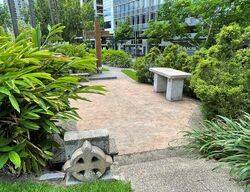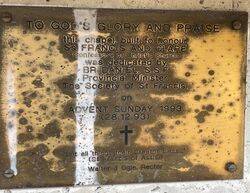
Saint Francis & Saint ClarePrint Page 
The chapel commemorates Saint Francis of Assisi and Saint Clare of Assisi.
Francis of Assisi (1182 – 1226), venerated as Saint Francis of Assisi, also known in his ministry as Francesco, was an Italian Catholic friar, deacon, mystic and preacher. He founded the men's Order of Friars Minor, the women's Order of Saint Clare, the Third Order of Saint Francis and the Custody of the Holy Land. Francis is one of the most venerated religious figures in Christianity.
St. Clare of Assisi was born in Assisi on July 16, 1194, as Chiara Offreduccio, the eldest daughter of Favorino Sciffi, Count of Sasso-Rosso and his wife Ortolana. As a young girl, Clare dedicated herself to prayer. At 18-years-old, she heard St. Francis of Assisi preach during a Lenten service in the church of San Giorgio and asked him to help her live according to the Gospel. On Palm Sunday in 1212, Clare left her father's home and went to the chapel of the Porziuncula to meet with Francis. While there, Clare's hair was cut off and she was given a plain robe and veil in exchange for her rich gown.
Clare joined the convent of the Benedictine nuns of San Paulo under Francis' orders. When her father found her and attempted to force her back into his home, she refused and professed that she would have no other husband than Jesus Christ. In order to give her the greater solitude she desired, Francis sent Clare to Sant' Angelo in Panzo, another Benedictine nuns monastery.
Clare's sister Catarina, who took the name Agnes, joined her at this monastery. The two remained there until a separate dwelling was built for them next to the church of San Damiano.
Overtime, other women joined them, wanting to also be brides of Jesus and live with no money. They became known as the "Poor Ladies of San Damiano." They all lived a simple life of austerity, seclusion from the world, and poverty, according to a Rule which Francis gave them as a Second Order. St. Clare and her sisters wore no shoes, ate no meat, lived in a poor house, and kept silent most of the time. Their lives consisted of manual labor and prayer.
Following Francis' death, Clare continued to promote her order, fighting off every attempt from each Pope trying to impose a rule on her order that would water down their "radical commitment to corporate poverty."
On August 9, 1253, Pope Innocent IV declared Clare's rule would serve as the governing rule for Clare's Order of Poor Ladies. Two days later, Clare died at 59-years-old. Her remains were placed in the chapel of San Giorgio while the church dedicated to her remains was being built. At Pope Innocent's request, the canonization process for Clare began immediately, and two years later in 1255, Pope Alexander IV canonized Clare as Saint Clare of Assisi.
The Order of Poor Ladies was officially changed to the Order of Saint Clare in 1263 by Pope Urban IV.
Location
| Address: | 32 Wickham Terrace, All Saints Anglican Church, Spring Hill, 4000 |
|---|---|
| State: | QLD |
| Area: | AUS |
| GPS Coordinates: | Lat: -27.464307 Long: 153.028298 Note: GPS Coordinates are approximate. |
Details
| Monument Type: | Structure |
|---|---|
| Monument Theme: | Culture |
| Sub-Theme: | Religion |
Dedication
| Actual Monument Dedication Date: | Tuesday 28th December, 1993 |
|---|
Plaque :
To God`s glory be the praise
This chapel, built to honour SS Francis and Clare (Confessors of Christ`s Church) was dedicated by Br Daniel. S.S.F. Provincial Minister, the Society of St Francis, on Advent Sunday, 1993
( 28. 12. 93).
`Let all things their Creator bless... ` (St Francis of Assisi)
Walter J Ogle, Rector







